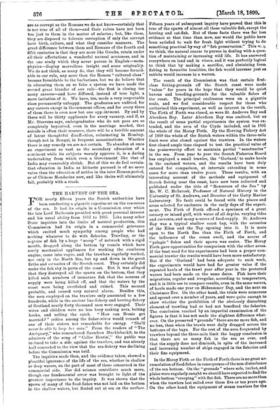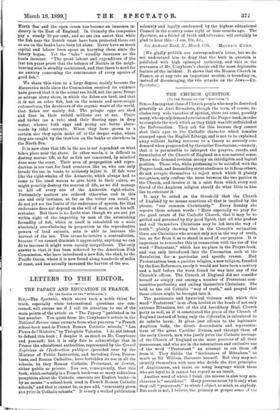THE HARVEST OF THE SEA.
FOR nearly fifteen years the Scotch authorities have been conducting a gigantic experiment on the resources of the sea. It had its origin in a Commission over which the late Lord Dalhousie presided with great personal interest and his usual ability from 1883 to 1885. Like many other State inquiries into the limits of natural production, this Commission had its origin in a commercial grievance which excited much sympathy among people who had nothing whatever to do with fisheries. Trawling, or the capture of fish by a huge " scoop " of network with a rigid mouth, dragged along the bottom by vessels which have costly mechanical appliances for working the cumbrous engine, came into vogue, and the trawlers regularly worked, not only in the North Sea, but up and down in the great firths and estuaries of the Scotch coast. They certainly did make the fish shy in parts of the coast. But it was alleged that they destroyed all the spawn on the bottom, that they killed such numbers of immature fish that the sources of supply were being killed off, and that the waters by the coast were being overfished and ruined. This seemed probable, and caused very natural alarm. Besides this, the men employed on the trawlers only amounted to a few hundreds, while in the ancient line-fishery and herring-fishery of Scotland nearly forty thousand men were engaged. Their wives and children were no less busy making nets, baiting hooks, and selling the catch. "How can Bessie get married P" critics among the fisher-wives would remark of one of their sisters not remarkable for energy. "She'll wever be able to keep her man." From the readers of "The Antiquary," who remembered Saunders Mucklebackit, to the admirers of the song of "Caller Herrin'," the public was inclined to take a side against the trawlers, and was already half converted to the view that the sea-fishery was declining before the Commission was held.
The inquiries made then, and the evidence taken, showed a plentiful ignorance of the life of the sea, whether in shallow or deep waters, on the part of most of those concerned in the commercial aide. Nor did science contribute much more, though one fundamental error was brought to light of the greatest importance to the inquiry. It was shown that the spawn of many of the food-fishes was not laid on the bottom in the shallow waters, but floated out at sea on the surface.
Fifteen years of subsequent inquiry have proved that this is true of the spawn of almost all these valuable fish, except the herring and cat-fish. But of these facts there was far less evidence at that time than now, nor would the public have been satisfied to wait for fresh light without trying to do something practical by way of "fish preservation." This W..3, we think, the natural course to pursue in dealing with a ques- tion of maintaining or increasing wild life. It has answered everywhere on land and in rivers, and it was perfectly logical to think that by making a sacrifice, and abstaining from fishing in favourite localities, the fish would increase just as rabbits would increase in a warren.
The result of the Commission was that certain first- class fishing-grounds off the Scotch coast were made " taboo " for years in the hope that they would be quiet havens and breeding-grounds for the valuable fishes of the coast. The principal enclOsures were on a gigantic scale, and we feel considerable respect for those who authorised this experiment, as well as interest in the result. The Firth of Forth was closed, so were St. Andrews Bay and Aberdeen Bay. Later Aberdeen Bay was omitted, but as the result of some partial experiments the system was ex- tended, and the area of the Clyde included, and in 1891 the whole of the Moray Firth. By the Herring Fishery Act of 1889 the whole of the Scotch waters within the three-mile limit were also closed against the trawlers. In the waters first closed ample time elapsed to test the practical value of the praiseworthy effort to maintain partial "sanctuaries" in the sea. From year to year the Scotch Fisheries Board has employed a small trawler, the Garland,' to make hauls
in the enclosed waters, and the results have been duly entered for comparison, at intervals extending in some oases for more than twelve years. These results, with an interesting account of the methods and equipment of Scotch fishing near the coast, have now been collected and published under the title of "Resources of the Sea" by Mr. W. C. McIntosh, Professor of Natural History in the University of St. Andrews, and Director of the Getty Marine Laboratory. No fault could be found with the places and areas selected for enclosure in the early days of the experi- ment The Firth of Forth offered a specimen of a great estuary or inland gulf, with water of all depths, varying tides and currents, and many sources of food-supply. St. Andrews Bay was a typical shallow coast bay, with the estuaries of the Eden and the Tay opening into it. It is more open to the North Sea than the Firth of Forth, and the influences of the ocean swell, and the access of " pelagic " fishes and their spawn was easier. The Moray Firth gave opportunities for comparison with the other areas. If the boat used for the experiments had been a proper com- mercial trawler the results would have been more satisfactory. But if the 'Garland ' had been adequate to such work, the experiments would have had far greater value if the repeated hauls of the trawl year after year in the protected waters had been made on the same dates. Fish have their migrations, regular and irregular, according to temperature, and it is little use to compare results, even in the same waters, of hauls made one year on Midsummer Day, and the next on Christmas Eve. On the other hand, the trials were numerous and spread over a number of years, and were quite enough to show whether the prohibition of the obviously disturbing element of trawling had or had not benefited the fisheries. The conclusion reached by an impartial examination of the figures is that it has not made the slightest difference what- ever. On the preserved "grounds" there are no more fish, and no less, than when the trawls were daily dragged across the bottoms of the bays. For the rest of the area frequented by trawlers beyond the three-mile limit the happy conclusion is that there are as many fish in the sea as ever, and that the supply does not diminish, in spite of the increased and increasing number of ships engaged in the fisheries and their fine equipment.
In the Moray Firth or the Firth of Forth there is no great ac. cumulation of food-fishes in consequence of the non-disturbance of the sea bottom. On the "grounds" where sole, turbot, and plaice were regularly caught we should have expected to find the whole bottom "creeping" with flat-fish. There are no more than when the trawlers last sailed over them five or ten years ago. On the other hand, the equipment of steam trawlers for the
North Sea and the open ocean has become an immense in- dustry in the East of England. In Grimsby the companies pay a steady 10 per cent, and no one can assert that while the fish near the Scotch coast have been protected those out at sea on the banks have been let alone. Never have so much capital and labour been spent on harrying them since the fishery began. Yet the " take " steadily increases as the boats increase. "The great labour and expenditure of the last ten years prove that the balance of Nature in the neigh- bouring seas is steadily maintained, and that there is need for no anxiety concerning the continuance of every species of good fish."
We share this view to a large degree, mainly because the discoveries made since the Commission received its evidence have proved that it is the actual sea itself, not the mere fringe or selvage along shore, in which the fishes are bred, and that it is net on other fish, but on the minute and microscopic entomostraca, the devourers of the organic waste of the world, that fishes are mainly fed. The pelagic eggs are shed and float in their untold millions out at sea. Plaice and turbot (as a rule) shed their floating eggs in deep water, whence both eggs and young are borne shore- wards by tidal currents. When they have grown to a certain size they again make off to the deeper water, where they are caught by the trawlers on the banks or elsewhere in the North Sea.
It is now clear that life in the sea is not dependent on what takes place near the shore. In other words, it is difficult to destroy marine life, so far as fish are concerned, by mischief done near the coast. Their area of propagation and repro- duction is too vast for land creatures like us, who can only invade the sea in boats, to seriously injure it. If fish were like the right-whales of the Antarctic, which always had to come to the coast waters to give birth to their calves, we might possibly destroy the sources of life, as we did manage to kill off every one of the Antarctic right-whales. Fortunately matters are ordered otherwise, and in this one and only instance, so far as the writer can recall, we do not yet see the limits of the endurance of species, for that endurance does not depend on the will of man, or on his self- restraint. But there is no doubt that though we are not yet within sight of the impairing by man of the astonishing fecundity of fish, which in itself is calculated on a scale absolutely overwhelming in proportion to the reproductive powers of land animals, man is able to increase the harvest of the sea. This seems to involve a contradiction, because if we cannot diminish it appreciably, anything we can do to increase it might seem equally insignificant. The only answer is that it has been achieved by the American Fish Commission, who have introduced a new fish, the shad, to the Pacific Ocean, where it is now found along hundreds of miles of coast, and has actually increased the harvest of the sea.







































 Previous page
Previous page